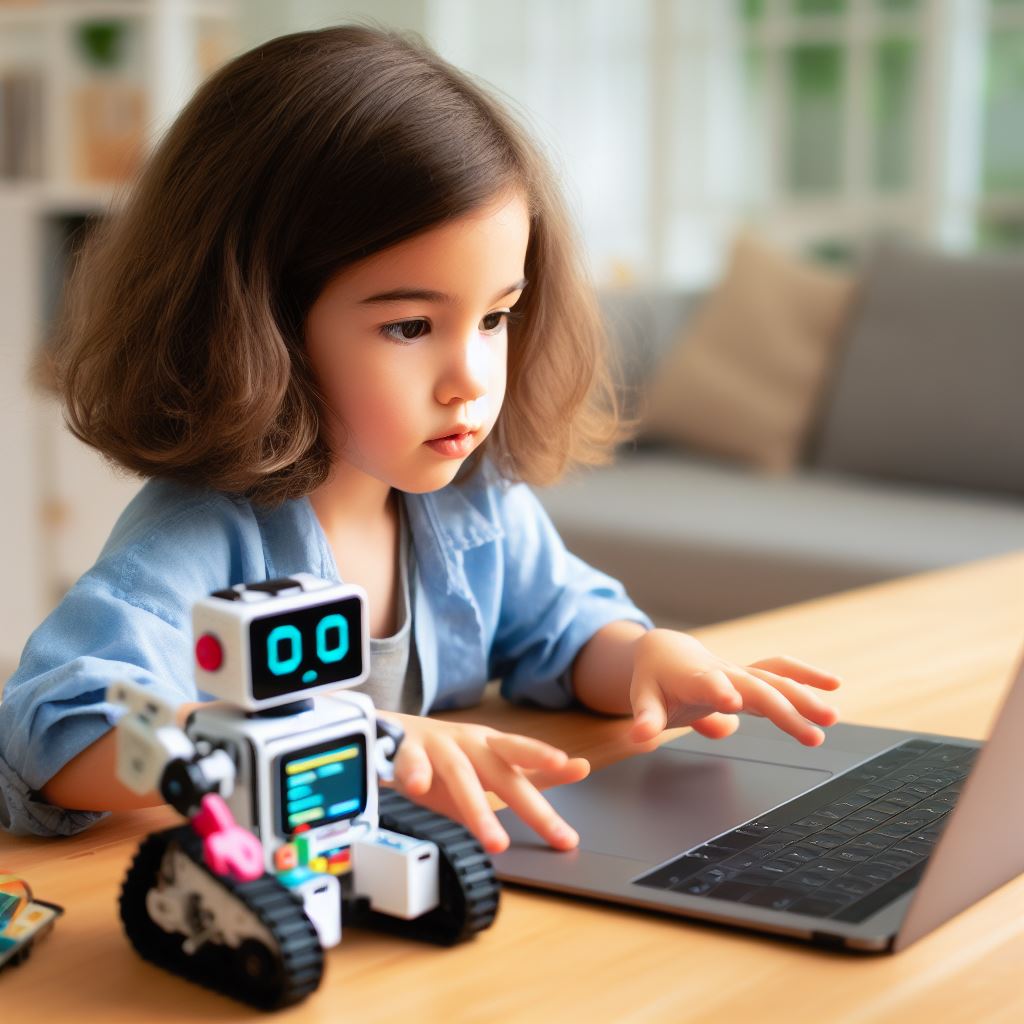Introduction
This section will explore how coding robots actively help improve logical thinking skills.
Coding robots have become increasingly popular tools for developing logical thinking skills in children.
These robots allow kids to learn the basics of programming through hands-on activities and interactive experiences.
Logical thinking skills are crucial for problem-solving, decision-making, and understanding complex concepts.
A. Brief explanation of coding robots
Coding robots are physical devices that can be programmed to perform specific tasks.
They usually come with a user-friendly interface and a variety of sensors and motors.
Children can code these robots by giving them instructions using block-based programming languages.
B. Importance of logical thinking skills
Logical thinking skills help individuals analyze information, make sound judgments, and solve problems effectively.
These skills are essential in various fields, including science, technology, engineering, mathematics (STEM), and computer science.
By using coding robots, children can develop logical thinking skills in a fun and engaging way.
When children code robots, they learn how to break down complex problems into smaller, manageable steps.
They also learn about cause and effect and how to connect different actions to achieve desired outcomes.
Coding robots promote critical thinking and creative problem-solving, as children must think logically to troubleshoot issues.
Furthermore, coding robots enhance children’s spatial awareness, sequencing abilities, and logical reasoning.
These skills are transferable to other areas of life and can benefit children academically and in their future careers.
Tech Consulting Tailored to Your Coding Journey
Get expert guidance in coding with a personalized consultation. Receive unique, actionable insights delivered in 1-3 business days.
Get StartedOverall, coding robots provide an interactive and hands-on approach to developing vital logical thinking skills.
Basically, coding robots offer an exciting way for children to enhance their logical thinking skills.
By engaging in coding activities with these robots, children can acquire problem-solving abilities that are valuable for their overall development.
The Role of Coding Robots in Developing Logical Thinking Skills
Coding robots have emerged as valuable tools in enhancing logical thinking skills among individuals, especially children.
These robots provide a hands-on learning experience that engages users and encourages critical thinking.
Let’s explore the fascinating world of coding robots and understand how they contribute to the development of logical thinking skills.
A. Examples of Coding Robots
Several coding robots have gained popularity in recent years due to their effectiveness in promoting logical reasoning. One such example is the LEGO Mindstorms series.
These robots allow users to build and program their own creations using LEGO bricks and a compatible software.
Another notable coding robot is Bee-Bot. This robot is specifically designed for younger children and helps them learn basic programming concepts through directional commands.
Additionally, there is Ozobot, a tiny robot that follows drawn lines and can be programmed using color codes.
This robot exposes users to both visual programming and problem-solving skills.
B. How Coding Robots Work
Coding robots typically come with a visual programming interface that allows users to input instructions.
These instructions are then translated into commands that the robot can understand and execute.
For example, with LEGO Mindstorms, users can drag and drop different blocks of code to program their robot.
Build Your Vision, Perfectly Tailored
Get a custom-built website or application that matches your vision and needs. Stand out from the crowd with a solution designed just for you—professional, scalable, and seamless.
Get StartedThese blocks represent various actions such as moving, turning, and detecting obstacles.
Once the program is complete, the robot can be connected to a computer or mobile device, and the code is transferred to the robot’s processor.
The robot then follows the instructions and executes the programmed actions accordingly.
C. How Coding Robots Engage Users in Logical Thinking
Coding robots prompt users to think logically and sequentially while designing programs.
They offer an interactive environment that requires problem-solving and critical thinking skills.
By experimenting with different commands and seeing the results, users learn to analyze outcomes, identify errors, and make necessary adjustments.
This iterative process fosters logical thinking and enhances problem-solving abilities.
Moreover, coding robots often present challenges and puzzles that users must solve through programming.
These challenges encourage users to break down complex problems into smaller, manageable steps, promoting a systematic approach to logical thinking.
Coding robots are powerful educational tools that promote the development of logical thinking skills.
Through hands-on programming experiences, users learn to think critically, solve problems, and approach challenges systematically.
By interacting with coding robots like LEGO Mindstorms, Bee-Bot, or Ozobot, individuals are exposed to essential programming concepts and encouraged to explore the endless possibilities of logical thinking.
So, whether you’re a child, student, or even an adult interested in coding and logical thinking, dive into the world of coding robots and unlock your potential!
Read: Scala: The Language for Big Data and Web Apps
Optimize Your Profile, Get Noticed
Make your resume and LinkedIn stand out to employers with a profile that highlights your technical skills and project experience. Elevate your career with a polished and professional presence.
Get NoticedBenefits of Coding Robots in Improving Logical Thinking Skills
Coding robots are becoming increasingly popular tools for enhancing logical thinking skills in both children and adults.
These innovative devices offer a range of benefits that contribute to the development of problem-solving abilities, critical-thinking skills, creativity, innovation, and analytical skills.
A. Enhancing Problem-Solving Abilities
Coding robots provide an interactive and hands-on approach to problem-solving.
By programming these robots, individuals are required to think logically and strategically to achieve desired outcomes.
This process helps enhance their problem-solving abilities by encouraging them to break down complex problems into smaller, manageable tasks.
The repetitive nature of coding robots also allows individuals to experiment and refine their solutions, promoting a trial-and-error approach to problem-solving.
Through this iterative process, individuals develop perseverance, resilience, and the ability to learn from their mistakes.
B. Developing Critical-Thinking Skills
Coding robots stimulate critical thinking by necessitating individuals to analyze situations, identify patterns, and make informed decisions.
When programming a robot, individuals need to think step-by-step and consider the consequences of each action.
This systematic approach to coding fosters logical reasoning and the ability to think critically.
Furthermore, coding robots often present individuals with open-ended challenges, encouraging them to think creatively to find innovative solutions.
This promotes the cultivation of diverse perspectives, the exploration of different possibilities, and the development of adaptive thinking skills.
C. Fostering Creativity and Innovation
Coding robots provide a platform for individuals to unleash their creativity and showcase their innovative ideas.
By engaging in the process of coding, individuals have the opportunity to translate their unique concepts into practical and tangible applications.
Moreover, coding robots often come with various sensors, motors, and components that can be utilized creatively to accomplish different tasks.
This flexibility allows individuals to experiment with different functionalities and encourages them to think outside the box to develop imaginative solutions.
D. Strengthening Analytical Skills
Through coding robots, individuals develop strong analytical skills by learning to observe, interpret, and evaluate data.
These robots often provide feedback and data on their performance, enabling individuals to analyze and identify areas for improvement.
Coding robots also emphasize the importance of logical sequencing and precise instructions.
Individuals are required to break down tasks into smaller steps and consider the cause-and-effect relationship between different actions.
This practice enhances their analytical thinking and their ability to analyze complex problems efficiently.
The use of coding robots offers several significant benefits in improving logical thinking skills.
By enhancing problem-solving abilities, developing critical-thinking skills, fostering creativity and innovation, and strengthening analytical skills, these robots provide individuals with valuable opportunities for skill development and personal growth.
Whether it’s children learning the basics of coding or adults looking to enhance their logical thinking, coding robots serve as effective tools for honing these essential skills.
As technology continues to evolve, coding robots will undoubtedly play a vital role in nurturing logical thinking skills in various educational and professional settings.
Read: Integrating Google Maps in Your Android Application

Real-Life Applications of Coding Robots in Logical Thinking
Coding robots have emerged as powerful tools for improving logical thinking skills in various fields.
Let’s explore their real-life applications in the education sector, workplace training, skill development, and even rehabilitation and therapy.
A. Education sector
In the education sector, coding robots provide students with hands-on experience in problem-solving and logical reasoning.
Through programming these robots, students learn to think critically and analytically, as they have to create a logical sequence of commands for the robot to follow.
This process helps develop their problem-solving skills and fosters a deep understanding of cause and effect relationships.
Moreover, coding robots are used to teach various subjects, such as math and science, in a more interactive and engaging way.
By incorporating coding into these subjects, students develop a deeper understanding of abstract concepts and can apply their logical thinking skills to real-life scenarios.
For example, they can program a robot to solve complex math problems or conduct scientific experiments autonomously.
B. Workplace training and skill development
In the workplace, coding robots are utilized for training and skill development purposes.
They offer employees the opportunity to enhance their logical thinking skills through programming and problem-solving tasks.
This enables them to work more efficiently and effectively in their respective roles.
Coding robots can simulate real-life business scenarios, allowing employees to practice critical thinking and decision-making skills.
For instance, in a simulated customer service environment, employees can program a robot to respond to different customer inquiries, thereby improving their logical thinking and problem-solving abilities.
C. Rehabilitation and therapy
Additionally, coding robots are increasingly being used in rehabilitation and therapy settings.
They provide a fun and engaging way for individuals to regain cognitive and motor skills.
People recovering from strokes or other neurological conditions can use coding robots to improve their logical thinking, memory, and coordination.
These robots can be programmed to complete specific tasks that require individuals to think logically and engage their problem-solving abilities.
For instance, patients may program the robot to navigate through a maze, stimulating their cognitive and motor functions.
Ultimately, coding robots offer a multitude of real-life applications for improving logical thinking skills.
In the education sector, they enhance students’ problem-solving abilities and deepen their understanding of various subjects.
In the workplace, coding robots aid in training and skill development, enabling employees to think critically and make informed decisions.
Moreover, in rehabilitation and therapy settings, coding robots provide a valuable tool for improving cognitive and motor skills.
With their interactive and engaging nature, coding robots have revolutionized the way logical thinking skills are developed and nurtured in various fields.
Read: Why C Remains a Fundamental Programming Language
Explore Further: Fintech in USA: How Coders are Revolutionizing Banking
Challenges and Limitations of Coding Robots in Logical Thinking Skill Development
Coding robots have become increasingly popular tools for improving logical thinking skills among individuals.
However, like any other educational tool, they have their own challenges and limitations that need to be considered.
In this blog section, we will delve into the challenges and limitations faced with coding robots in logical thinking skill development.
A. Lack of human interaction
One of the major challenges of using coding robots for improving logical thinking skills is the lack of human interaction.
Unlike traditional modes of learning, coding robots rely heavily on technology, which can hamper the development of essential social and communication skills.
Human interaction plays a crucial role in fostering collaboration, teamwork, and problem-solving abilities, which are vital for logical thinking.
B. Limited scope of problem complexity
Moreover, coding robots offer a limited scope of problem complexity.
While they can effectively teach the basics of coding and logical thinking, they often fail to provide sufficient challenges for advanced learners.
As a result, individuals may not be able to fully develop their problem-solving and critical thinking abilities, as they are confined to the constraints programmed within the robot.
C. Dependence on technology
Another notable limitation of coding robots in logical thinking skill development is the dependence on technology.
While technology has revolutionized education, overreliance on coding robots can hinder the development of independent thinking and creativity.
Problem-solving in the real world often requires thinking outside the box, which coding robots may not adequately stimulate.
Additionally, coding robots may unintentionally limit the diversity of thought and approaches to problem-solving.
These robots are programmed to follow specific instructions and algorithms, leaving little room for individual creativity and alternative perspectives.
This can hinder the development of flexible thinking and the ability to consider multiple solutions to a problem.
To overcome the drawbacks of coding robots, it is crucial to integrate them into a comprehensive educational program that includes human interaction and a diverse range of learning experiences.
Teachers can play a significant role in guiding and facilitating meaningful discussions and collaborations among students.
By combining coding robots with other educational tools and methodologies, a more holistic approach to logical thinking skill development can be achieved.
In a nutshell, coding robots have proven to be effective tools in improving logical thinking skills.
However, their limitations, such as the lack of human interaction, limited problem complexity, and dependence on technology, cannot be ignored.
It is essential to incorporate coding robots into a well-rounded educational program that encourages critical thinking, collaboration, and creativity.
By doing so, individuals can fully harness the benefits of coding robots while overcoming their challenges and limitations.
Read: Creating 2D Games in Unity: Step-By-Step Guide
Strategies for Maximizing the Benefits of Coding Robots in Improving Logical Thinking Skills
Coding robots have proven to be effective tools for enhancing logical thinking skills in learners of all ages.
By engaging in hands-on coding activities, students are able to develop problem-solving abilities, critical thinking skills, and logical reasoning.
To fully maximize the benefits of coding robots, here are some strategies to implement:
1. Combine coding robots with other learning methods
- Integrate coding robots into traditional classroom instruction to reinforce logical thinking concepts.
- Encourage students to connect their coding robot experiences with other subjects, such as math or science.
- Use coding robots as a supplement to online coding tutorials or resources to enhance understanding.
2. Encourage collaboration and teamwork
- Promote group activities where students have to work together to program and control the coding robots.
- Assign coding projects that require students to collaborate, share ideas, and solve problems collectively.
- Encourage communication and discussion among team members to foster critical thinking and logical reasoning.
3. Design diverse and challenging coding projects
- Create coding tasks that gradually increase in complexity, allowing students to progressively improve their logical thinking skills.
- Incorporate real-life scenarios into coding projects to stimulate critical thinking and problem-solving abilities.
- Introduce coding challenges that require students to think creatively and find multiple solutions.
By implementing these strategies, educators can effectively enhance the development of logical thinking skills in students through coding robots.
The benefits of coding robots extend beyond the improvement of logical thinking skills; students also gain several other valuable advantages:
- Enhanced problem-solving abilities: Coding robots provide hands-on experiences that require students to analyze and troubleshoot various coding challenges.
- Improved critical thinking: Engaging with coding robots helps students develop logical reasoning skills, enabling them to approach problems from different perspectives.
- Boosted creativity: Designing coding projects and experimenting with different solutions nurture students’ creativity and innovative thinking.
- Increased self-confidence: Successfully completing coding tasks and programming robots instills a sense of accomplishment and confidence in students.
Furthermore, coding robots help students develop important lifelong skills that are highly valued in various career paths:
- Computational thinking: Through coding robots, students learn how to break down complex problems into smaller, manageable tasks.
- Collaboration and teamwork: Working together to program and control coding robots promotes effective collaboration skills.
- Adaptability: Constantly engaging with coding robots exposes students to new challenges, allowing them to become more adaptable and flexible in problem-solving.
To sum it up, coding robots offer a powerful means of improving logical thinking skills in learners.
By combining coding robots with other learning methods, encouraging collaboration and teamwork, and designing diverse and challenging coding projects, educators can maximize the benefits of coding robots in developing logical thinking skills.
The advantages extend beyond logical thinking, fostering problem-solving abilities, critical thinking, creativity, self-confidence, and important lifelong skills.
Conclusion
A. Importance of Logical Thinking Skills
In this section, we’ve highlighted the critical significance of logical thinking skills.
These skills are essential for problem-solving, decision-making, and overall cognitive development.
B. Role of Coding Robots in Improving Logical Thinking
Coding robots are powerful tools for honing logical thinking.
They engage users in problem-solving, algorithm creation, and logical sequencing, which are vital components of logical reasoning.
C. Encouragement for Readers
We encourage readers to explore the world of coding robots.
Whether you’re a student, a professional, or simply someone interested in boosting your logical thinking abilities, these robots can be a fun and effective way to do so.
By actively involving yourself in coding and programming, you’ll not only enhance your logical thinking skills but also open doors to exciting opportunities in technology and innovation.
Start your journey today and unlock your full logical thinking potential!




